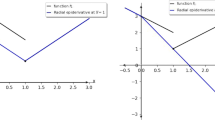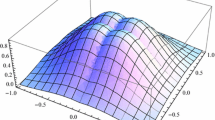Abstract
The total variation regularization for 2D radially symmetrical piecewise constant functions is considered in this paper. The system of equations that solves the direct problem of the total variation regularization with the use of subgradients is obtained. On the basis of the obtained system of equations, the algorithm of calculation of the extremal function is formulated and the geometrical interpretation of the extremal function is given with the use of the modified approach to constructing the taut string. The proposed algorithm of the total variation regularization is used in the 2D case for realizing the adaptive algorithm of the total variation regularization with the variable regularization parameter. The algorithmic complexity of the proposed algorithm of the 1D total variation regularization is equal to the complexity of the known Condat algorithm. The efficiency of the developed algorithm of the total variation regularization is illustrated with the help of computer modeling.











Similar content being viewed by others
REFERENCES
L. Rudin, S. Osher, and E. Fatemi, “Nonlinear total variation based noise removal algorithms,” Phys. D (Amsterdam) 60 (9), 259−268 (1992).
R. Acar and C. Vogel, “Analysis of bounded variation penalty methods for ill-posed problems,” Inverse Probl. 10, 1217−1229 (1994).
W. Allard, “Total variation regularization for image denoising, ii. Examples,” SIAM J. Imag. Sci. 1, 400−417 (2008).
S. Boyd and L. Vandenberghe, Convex Optimization (Cambridge Univ. Press, New York, 2004), Vol. 1.
A. Chambolle and T. Pock, “An introduction to continuous optimization for imaging,” Acta Numerica 25, 161−319 (2016).
P. Davies and P. Kovac, “Local extremes, runs, strings and multiresolution,” Ann. Statist. 29, 1−65 (2001).
L. Condat, “A direct algorithm for 1-D total variation denoising,” IEEE Signal Process. Lett. 20, 1054−1057 (2013).
S. Makovetskii and V. K. Voronin, “A generalized condat’s algorithm of, 1d total variation regularization,” 10396, 103962K (2017).
S. Makovetskii and V. K. Voronin, “Total variation regularization with bounded linear variations,” 9971, 99712 (2016).
D. Strong and T. Chan, “Edge-preserving and scale-dependent properties of total variation regularization,” Inverse Problems 19, 165−187 (2003).
ACKNOWLEDGMENTS
This work was supported by the Russian Science Foundation, grant no. 15-19-10010.
Author information
Authors and Affiliations
Corresponding author
Additional information
Translated by I. Efimova
Rights and permissions
About this article
Cite this article
Kober, V.I., Makovetskii, A.Y., Voronin, S.M. et al. A Fast Algorithm of Regularization of the Total Variation for the Class of Radially Symmetrical Functions. J. Commun. Technol. Electron. 64, 1500–1507 (2019). https://doi.org/10.1134/S1064226919120064
Received:
Revised:
Accepted:
Published:
Issue Date:
DOI: https://doi.org/10.1134/S1064226919120064




